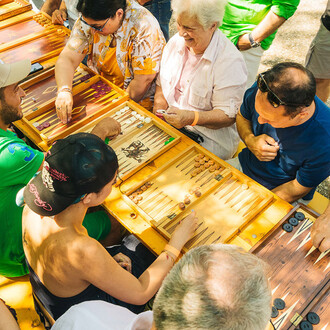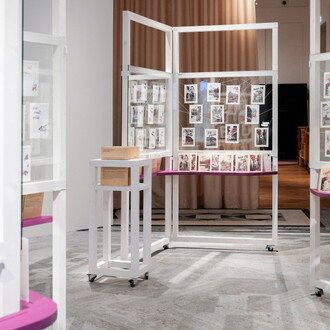The circumstances arising from the material combinations in Michael Kienzer’s work, the changing relations, also are the subject, ultimately, of the central installation Flyer. In a separate room, visitors are invited to move among sculptures made of metal sheets, bent and folded, consisting of two, three or four parts. The sheets, reminiscent of paper due to the fine shadings of the folds, are assembled into oversized flyers, brochures or invitation cards, and in this form are held together merely by threaded rods and magnets. The titles of the objects, for instance, are Signalorange/Beigerot (Flyer 2-teilig), Türkisblau/Rapsgelb/Zinkgelb (Flyer 3-teilig), Kobaltblau/Zinkgelb/Blaulila/Weißgrün (Flyer 4-teilig), Lichtgrün/Orientrot/Orientrot (Flyer 3-teilig), Weißgrün/Signalviolett (Flyer 2-teilig). Thus they describe what visitors to the exhibition get to see: colour in its purest form, and colour in connection with other colours, colour in relation to form, colour in relation to material, colour in relation to the exhibition room. An entire colour theory is spread out here for whoever is prepared to let themselves in.
(Franz Thalmair, Michael Kienzer, Artforum, November 2018, p. 254)
The exhibition grau und farbig at Galerie Elisabeth & Klaus Thoman Vienna in 2018 received huge media attention and provided Michael Kienzer with an increased international resonance. After more than a dozen exhibitions and joint projects with the artist, Galerie Elisabeth & Klaus Thoman Innsbruck now presents new works, some of them conceived for the occasion. The series Flyer once more takes centre stage. Building on it in terms of form and dimension, Michael Kienzer introduces monumental sculptures that nonetheless preserve their fragility and momentariness. On the contrary, the tension between massive materialism and playful lightness in appearance is further enhanced. The exhibition concept is expanded on by way of a number of smaller sculptures. Seemingly organic shapes, suggesting softness and flexibility in their amorphous appearance, they tempt the viewer to touch and mould them, yet are made of massive metal. Kienzer’s collages only ostensibly are pictorial-decorative, cleverly layered as they are from various materials resp. carriers of meaning. As so often in his art, what matters here to Kienzer is the contrast, between attraction and distance, order and chaos, function and dysfunction, openness and closedness, as well as various constellations of carrying and resting.
Michael Kienzer, born in Steyr, Upper Austria, in 1962, received the Otto Mauer Award in 2001, the Austrian Art Award for Visual Arts in 2012, and the Anerkannt. Etabliert. Angekommen. Art Austria Award in 2013. He lives and works in Vienna.
Numerous international exhibitions and public space projects since 1984, e.g. 2005 Neue Immobilien MAK Vienna; 2007 Vor Ort Museum für Gegenwartskunst Stift Admont; 2009 Out site_02 MUMOK Vienna; 2010 Malerei: Prozess und Expansion MUMOK Vienna; 2010 Triennale Linz; 2010 Linea Kunsthaus Zug; 2011 Fünf Räume Austrian Cultural Forum New York; 2011 54th Biennale di Venezia Glasstress Palazzo Cavalli Franchetti; 2012 Logik und Eigensinn Kunsthaus Graz; 2014 Gironcoli + Kienzer Galerie Elisabeth & Klaus Thoman Innsbruck; 2016 24 von 274.668 Tagen Klangraum Krems Minoritenkirche; 2016 ABSTRAKT – SPATIAL. Malerei im Raum Kunsthalle Krems; 2016 The Body Extended: Sculpture and Prosthetics Henry Moore Institute Leeds; 2017 Lose Dichte Gerhard-Marcks-Haus Bremen; 2017 Lärm und Linien Kunsthaus Zug; 2018 grau und farbig Galerie Elisabeth & Klaus Thoman Vienna; 2019 Zu viel ist nicht genug! Die Schenkung “Sammlung Atelier” Universalmuseum Joanneum Graz; 2019 Austrian Secrets The Galaxy Museum of Contemporary Art Chongqing China.












